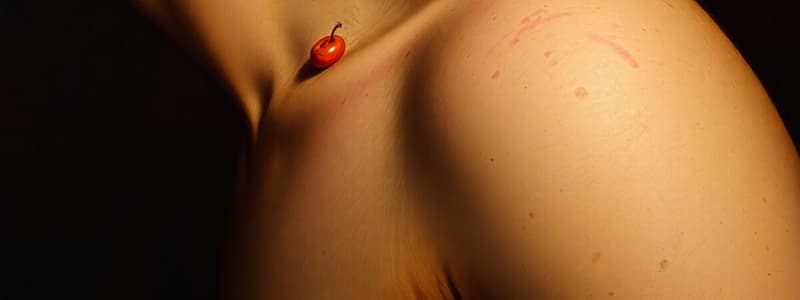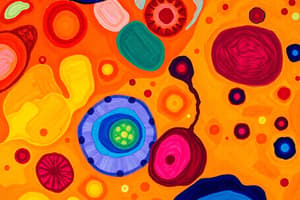Podcast
Questions and Answers
What is the average number of nevi in a person's body?
What is the average number of nevi in a person's body?
40
Do our moles change?
Do our moles change?
True (A)
Which type of nevus is characterized by nests of melanocytes purely in the epidermis?
Which type of nevus is characterized by nests of melanocytes purely in the epidermis?
- Compound Nevi
- Junctional Nevi (correct)
- Intradermal Nevi
What is a characteristic appearance of junctional nevi?
What is a characteristic appearance of junctional nevi?
In what age range is the maximum number of nevi present?
In what age range is the maximum number of nevi present?
Nevi remain stable throughout a person's life.
Nevi remain stable throughout a person's life.
Which type of nevi has nevus cells all located in the dermis?
Which type of nevi has nevus cells all located in the dermis?
Study Notes
Nevi Overview
- Nevi, commonly known as moles, can be classified into three types: junctional, compound, and intradermal.
- The development and maturation of nevi can change throughout a person's life.
Fitzpatrick Skin Type
- Junctional Nevi:
- Youngest type, characterized by hyperpigmentation, flatness (macules), and a fried-egg appearance (darker center).
- Compound Nevi:
- Developed from junctional nevi, these are elevated (papules) that form as individuals age.
- Intradermal Nevi:
- Formed in middle age (40s to 50s), presented as dome-shaped papules, with or without hair.
Incidence & Prevalence
- Nevi are subject to change throughout life, maturing and potentially disappearing.
- Maximum number of nevi occurs between ages 20-25, averaging around 40.
- Nevi begin as small, flat pigmented macules, progressing from junctional to compound to intradermal forms.
- Many nevi flatten and fade, disappearing completely by age 90.
Histologic Differences of Nevi
- Junctional Nevi:
- Nests of melanocytes are located purely in the epidermis.
- Compound Nevi:
- Nevus cells migrate to the upper dermis while remaining in the epidermis, showing mixed dermal and epidermal cells.
- Intradermal Nevi:
- Melanocytes are entirely within the dermis.
Cellular Nevi Characteristics
- Cellular nevi typically appear early in life and increase in number over 2-3 decades, followed by a steady decline.
- Females are more likely to have more nevi than males; Caucasians tend to have more than African Americans.
- Sun exposure correlates with an increased number of moles, primarily on exposed skin areas.
Junctional Nevus Specifics
- Characteristics include:
- Smooth, hairless, light to dark brown macules.
- May exhibit a target or fried-egg appearance.
- Locations commonly include palms, soles, and scrotum.
- May be present at birth or appear between ages 3-18.
Studying That Suits You
Use AI to generate personalized quizzes and flashcards to suit your learning preferences.
Description
Test your knowledge on nevi, premalignant conditions, and both nonmelanoma and melanoma skin tumors. This quiz is based on the lecture notes provided by Dr. Del Rio and includes key concepts from dermatology. Dive into the specifics of skin types and their implications in skin pathology.




